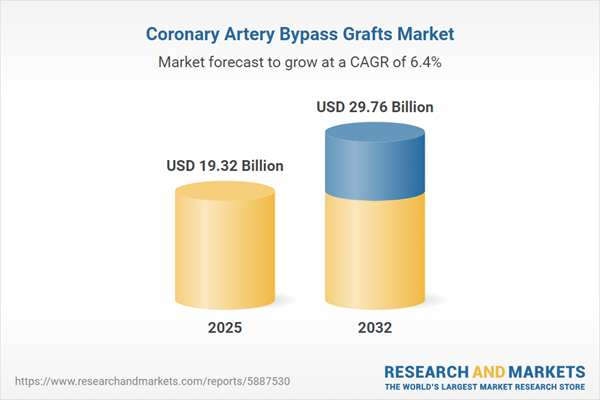Speak directly to the analyst to clarify any post sales queries you may have.
The Coronary Artery Bypass Grafts Market is rapidly evolving, driven by clinical innovation, regional demand shifts, and strategic technology investments across supply chains. Its growth is influenced by complex regulatory changes, the adoption of novel procedures, and the integration of new device technologies.
Market Snapshot: Coronary Artery Bypass Grafts Market Size and Growth
The Coronary Artery Bypass Grafts Market expanded from USD 18.16 billion in 2024 to USD 19.32 billion in 2025. Forecasts indicate sustained growth at a CAGR of 6.36%, with the market projected to reach USD 29.76 billion by 2032. This upward trajectory reflects increasing demand for precision-driven cardiovascular intervention, ongoing advancements in procedural techniques, and the widespread adoption of minimally invasive surgical solutions.
Scope & Segmentation
The market analysis explores distinct opportunities and challenges through a comprehensive segmentation approach.
- Graft Types: Arterial and venous grafts each play pivotal roles based on case complexity and longevity requirements.
- Procedure Types: Coverage includes conventional on-pump CABG, minimally invasive approaches (endoscopic and robotic), and off-pump methods tailored for high-risk cohorts.
- End Users: Hospitals, cardiac centers, and ambulatory surgical centers represent key service environments, each aligned to specific patient profiles and intervention acuity.
- Applications: Solutions address multi-vessel disease and single-vessel disease, catering to differentiated clinical needs and treatment strategies.
- Regional Exposure: Analysis spans the Americas (United States, Canada, Mexico, Brazil, Argentina, Chile, Colombia, Peru), Europe, Middle East & Africa (with detailed coverage across UK, Germany, France, Italy, Spain, Russia, Netherlands, Sweden, Poland, Switzerland; Middle East—including UAE, Saudi Arabia, Qatar, Turkey, Israel; and key African nations such as South Africa, Nigeria, Egypt, and Kenya), and Asia-Pacific (China, India, Japan, Australia, South Korea, Indonesia, Thailand, Malaysia, Singapore, Taiwan).
- Core Technologies: Covers developments in robotic assistance, advanced imaging, modular instrument systems, bioresorbable scaffolds, and vessel preservation techniques.
- Company Benchmarks: Strategic profiles include Terumo Corporation, Medtronic plc, Getinge AB, LivaNova PLC, Edwards Lifesciences Corporation, B. Braun Melsungen AG, Baxter International Inc., Teleflex Incorporated, CryoLife, Inc., and ConMed Corporation.
Key Takeaways for Decision-Makers
- Growth is powered by a strong clinical shift toward minimally invasive CABG, with robotic platforms and endoscopic methods enhancing patient recovery and operational dexterity.
- Advanced imaging tools now enable surgeons to monitor graft patency in real-time, supporting consistent clinical outcomes and better vessel longevity.
- Hospitals, while remaining the dominant delivery channel, are joined by ambulatory surgical centers for selected cases, indicating a diversifying landscape in procedural settings.
- Industry leaders are investing in next-generation coatings, vessel-mimetic grafts, and integrated modular systems to address durability, set-up efficiency, and patient-centric outcomes.
- The interplay of established suppliers and innovative startups continues to foster technological differentiation, supporting tailored product portfolios for regional and clinical specialization.
- Expanding surgical expertise in Asia-Pacific, alongside localized manufacturing growth, has broadened access to both advanced and conventional grafting techniques, increasing competitive intensity across the region.
Tariff Impact: Navigating New Cost Pressures in the United States
The landscape has shifted due to the introduction of U.S. import tariffs on key medical devices and materials in 2025. These policies have prompted hospitals and manufacturers to revisit sourcing strategies, explore dual-sourcing options, and collaborate with domestic suppliers. Resulting supply chain adjustments prioritize lean inventory management and localized production, which supports ongoing resilience and mitigates volatility in procurement and operational costs.
Methodology & Data Sources
This report is based on primary qualitative interviews with surgeons and healthcare executives. It leverages secondary research from peer-reviewed publications, clinical trial databases, regulatory filings, and patent reviews. Data triangulation ensures reliable thematic insights, with expert validation guaranteeing transparency and analytical rigor throughout.
Why This Report Matters
- Consolidates critical insights on evolving CABG clinical practices, technological advancements, and segment trends for strategic decision-making.
- Enables stakeholders to align product development, supply chain adaptation, and market entry strategies with regional opportunities and regulatory shifts.
Conclusion
The Coronary Artery Bypass Grafts Market is positioned for ongoing advancement, shaped by technology adoption, regional demand evolution, and effective response to changing trade frameworks. Stakeholders equipped with this analysis will be well-positioned to anticipate shifts and drive market leadership.
Additional Product Information:
- Purchase of this report includes 1 year online access with quarterly updates.
- This report can be updated on request. Please contact our Customer Experience team using the Ask a Question widget on our website.
Table of Contents
3. Executive Summary
4. Market Overview
7. Cumulative Impact of Artificial Intelligence 2025
Companies Mentioned
The companies profiled in this Coronary Artery Bypass Grafts market report include:- Terumo Corporation
- Medtronic plc
- Getinge AB
- LivaNova PLC
- Edwards Lifesciences Corporation
- B. Braun Melsungen AG
- Baxter International Inc.
- Teleflex Incorporated
- CryoLife, Inc.
- ConMed Corporation
Table Information
| Report Attribute | Details |
|---|---|
| No. of Pages | 182 |
| Published | October 2025 |
| Forecast Period | 2025 - 2032 |
| Estimated Market Value ( USD | $ 19.32 Billion |
| Forecasted Market Value ( USD | $ 29.76 Billion |
| Compound Annual Growth Rate | 6.3% |
| Regions Covered | Global |
| No. of Companies Mentioned | 11 |









